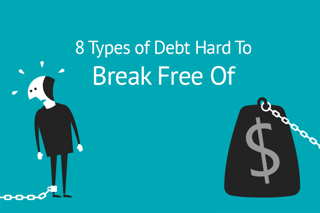 In my last two blogs, I looked at debts that aren’t discharged in a bankruptcy case. Two weeks ago I looked at debts that are never discharged - student loans, most income tax debt, obligations to pay child support or spousal maintenance, to name a few. These debts are presumed to be non-dischargeable in a bankruptcy case. That means that the creditor does not have to bring an action in bankruptcy court to determine that these kinds of debts are not subject to a bankruptcy debtor’s general discharge; if there is going to be a judicial determination of dischargeability, the bankruptcy debtor has to bring the action to determine whether the debt can be discharged in the bankruptcy case, and the presumption is that the debt is not subject to discharge.
In my last two blogs, I looked at debts that aren’t discharged in a bankruptcy case. Two weeks ago I looked at debts that are never discharged - student loans, most income tax debt, obligations to pay child support or spousal maintenance, to name a few. These debts are presumed to be non-dischargeable in a bankruptcy case. That means that the creditor does not have to bring an action in bankruptcy court to determine that these kinds of debts are not subject to a bankruptcy debtor’s general discharge; if there is going to be a judicial determination of dischargeability, the bankruptcy debtor has to bring the action to determine whether the debt can be discharged in the bankruptcy case, and the presumption is that the debt is not subject to discharge.
Last week I wrote about three types of debts that may not be discharged in a specific case. These are debts that are incurred by a debtor taking cash advances from a credit card totaling $950 or more within 70 days prior to the debtor filing a bankruptcy case, luxury purchases totaling $675 or more within 90 days of filing, and debts that are incurred by fraud. For these three types of debts, the creditor has to bring an action in a timely manor, the debtor must prove that he or she intended to pay back the charges/cash advances at the time the activity took place, or, in the case of a dispute regarding luxury purchases, that some of all of the purchases were not, in fact, luxury purchases for the purposes of the statute.
But in all three cases, the creditor is the party that must bring the action to determine that the debt is not subject to the debtor’s general discharge. If the creditor fails to act the debtor will have these debts discharged, even if the debtor’s behavior was such that the debt would be determined to be non-dischargeable had the creditor brought the action.
This week, I will look at one more type of debt that can be determined to not be discharged in a bankruptcy case, and I will look at the difference between debts not discharged in a chapter 7 case and debts not discharged in a chapter 13 case.
Willful and Malicious Injury
Section 523(a)(6) of the Bankruptcy Code provides that a debt incurred by a debtor because of the willful and malicious injury by the debtor to another entity or to the property of another entity can be excepted from discharge.
As is the case with the three types of debts I reviewed last week, there is no presumption that a debt caused by a willful and malicious injury be excepted from discharge. In order to have this type of debt excepted from discharge, the creditor has to bring an action in bankruptcy court, and the creditor has the burden of proving that the debt should not be discharged.
It’s important to note Congress deliberately did not narrow who the creditor can be in carving out this exception to discharge. The statute refers to an “entity,” not a person. Under the Bankruptcy Code’s definition section, the term entity refers to a “person, estate, trust, governmental unit and United States Trustee.” So the scope of who can be a creditor in under this statute is broad; however we are almost always talking about an injury to a person or to the property owned by a person.
The next question is what type of behavior falls under the willful and malicious injury standard. For almost one hundred years, courts held that an intentional act which results in a foreseeable injury, fit the definition of willful and malicious, and thus rendered a debt non-dischargeable. However, in 1998, the Supreme Court held that not only must the act be intentional, the debtor must intend an injury, also, even if the exact injury was not what the debtor intended. This court decision, 18 years ago, narrowed the scope of 523(a)(6), which results in fewer actions being brought to except a debt like this from discharge.
The Chapter 13 “Super Discharge”
One significant difference between chapter 7 and chapter 13 bankruptcy cases is that more types of debts can be discharged in a chapter 13 case than chapter 7. This is called the chapter 13 “super discharge.”
Section 1328 of the Bankruptcy Code defines what debts are discharged in a chapter 13 case. Unlike section 523, which lists 18 different types of debts that are not discharged in a chapter 7 case, section 1328 lists only 11 types of debts that are not subject to discharge in a chapter 13 case.
Here’s what is not discharged in either a chapter 7 or chapter 13 case:
- Most income tax debt
- Child support and alimony
- Criminal Fines and Restitution
- Death or injury caused by drunk driving
- Debts due to embezzlement or breach of a fiduciary duty
- Student loans
- Unlisted debts
- Willful and malicious injuries to people.
- Here are the debts that are not discharged in a chapter 7 case, but can be discharged in a chapter 13 case:
- Civil fines and penalties
- Non-child support or alimony financial obligations created by a divorce decree or decree
- of legal separation
- Debts created to pay non-dischargeable federal tax obligations
- Debts created to pay non-dischargeable state and/or local tax obligations
- Debts that were not discharged in a previous bankruptcy case due to the waiver or denial of discharge
- Government assistance repayment obligations
- Willful and malicious injury to property
It is worth noting that prior to the significant changes in the bankruptcy law that were made in 2005, there were more types of debt subject to the chapter 13 “super discharge” than there are now. However, there are still several types of debts that are difficult to discharge in a chapter 7 case that can be discharged in a chapter 13 case, and for that reason, people with debts like these should seriously consider using a chapter 13 payment plan as a way to resolve these obligations by making affordable monthly payments in a chapter 13 case.
People considering chapter 13 to discharge debt that is not dischargeable in a chapter 7 case should be cautioned, though: it is a requirement of chapter 13 that cases by filed by the debtor “in good faith.” Good faith requires that chapter 13 debtors be honest about the facts of their case, and not use chapter 13 to escape the payment of obligations imposed by other courts without first making a good faith effort to comply with other court orders.


